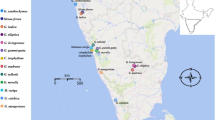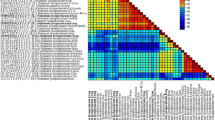Abstract
A new fusagra-like virus infecting papaya (Carica papaya L.) was genetically characterized. The genome of the virus, provisionally named "papaya sticky fruit-associated virus" (PSFaV), is a single molecule of double-stranded RNA, 9,199 nucleotides (nt) in length, containing two discontinuous open reading frames. Pairwise sequence comparisons based on complete RNA-dependent-RNA-polymerase (RdRp) sequences revealed identity of 79.4% and 83.3% at the nt and amino acid (aa) level, respectively, to babaco meleira-like virus (BabMelV), an uncharacterized virus sequence discovered in babaco (Vasconcellea x heilbornii) in Ecuador. Additional plant-associated viruses with sequence identity in the 50% range included papaya meleira virus (PMeV) isolates from Brazil. Phylogenetic analysis based on the amino acid sequences of the capsid protein (CP), RdRp, and CP-RdRp fusion protein genes placed PSFaV in a group within a well-supported clade that shares a recent ancestor with Sclerotium rolfsii RNA virus 2 and Phlebiopsis gigantea mycovirus dsRNA 2, two fungus-associated fusagraviruses. Genomic features and phylogenetic relatedness suggest that PSFaV, along with its closest relative BabMelV, represent a species of novel plant-associated virus classified within the recently established family Fusagraviridae.


Similar content being viewed by others
Data availability
The complete genome sequence reported here is available in the GenBank database under the accession number ON226840.
References
Wang L, Zhang J, Zhang H, Qiu D, Guo L (2016) Two novel relative double stranded RNA mycoviruses infecting Fusarium poae strain SX63. Int J Mol Sci 17:641
Sa Antunes TF, Maurastoni M, Madroñero LJ, Fuentes G, Santamaria JM, Ventura JA, Abreu EF, Fernandes AAR, Fernandes PMB (2020) Battle of three: The curious case of papaya sticky disease. Plant Dis 104(11):2754–2763
Maurastoni M, Sá Antunes TF, Abreu EFM, Ribeiro SG, Mehta A, Sanches MM, Fontes W, Kitajima EW et al (2023) A Capsid Protein Fragment of a Fusagra-like Virus Found in Carica papaya Latex Interacts with the 50S Ribosomal Protein L17. Viruses 15(2):541
Badillo VM, Leal F (2020) Taxonomy and botany of the Caricaceae. Hortic Rev 47:289–323
Morris TJ, Dodds JA, Jordan RL (1984) Plant viral double-stranded RNA. Annu Rev Phytopathol 22:151–168
Wayne-Hughes D, Galau G (1988) Preparation of RNA from cotton leaves and pollen. Plant Mol Biology Report 6:253–257
Halgren A, Tzanetakis IE, Martin RR (2007) Identification, Characterization, and Detection of Black raspberry necrosis virus. Phytopathology 97:44–50
Sá Antunes TF, Amaral RJV, Ventura JA et al (2016) The dsRNA Virus Papaya Meleira Virus and an ssRNA Virus Are Associated with Papaya Sticky Disease. PLoS ONE 11:e0155240
Jones S, Baizan-Edge A, Macfarlane S, Torrance L (2017) Viral Diagnostics in Plants Using Next Generation Sequencing: Computational Analysis in Practice. Front Plant Sci 8
Dinman JD, Icho T, Wickner RB (1991) A -1 ribosomal frameshift in a double-stranded RNA virus of yeast forms a gag-pol fusion protein. Proc Natl Acad Sci U S A 88(1):174–178. https://doi.org/10.1073/pnas.88.1.174PMID: 1986362; PMCID: PMC50772
Wallace IM, O'Sullivan O, Higgins DG, Notredame C (2006) M-Coffee: combining multiple sequence alignment methods with T-Coffee. Nucleic Acids Res. Mar 23;34(6):1692-9. https://doi.org/10.1093/nar/gkl091. PMID: 16556910; PMCID: PMC1410914
Kumar S, Stecher G, Li M, Knyaz C, Tamura K (2018) MEGA X: molecular evolutionary genetics analysis across computing platforms. Mol Biol Evol 35:1547–1549
Wickner RB, Ghabrial SA, Nibert ML, Patterson JL, Wang CC (2012) Totiviridae. In: King AMQ, Adams MJ, Carstens EB, Lefkowitz E (eds) Virus Taxon. Classif. Nomencl. viruses Ninth Rep. Int. Comm. Taxon. Viruses. Elsevier, San Diego, pp 639–650
Khalifa ME, MacDiarmid RM (2019) A novel totivirus naturally occurring in two different fungal genera. Front Microbiol 10:2318
Acknowledgments
Plant samples were collected under Genetic Resource Access permit number MAE-DNB-CM-2018-0098, granted by the Department of Biodiversity of the Ecuadorean Ministry of the Environment. The authors thank the papaya growers from all of the fields sampled in this study.
Funding
This work was partially funded by the Secretaría de Educación Superior, Ciencia, Tecnología e Innovación (Ecuadorean Science and Technology Secretariat) under the INEDITA Project Initiative (project number PIC-21-INE-ESPOL-001).
Author information
Authors and Affiliations
Contributions
Study conception and design: D.Q-A. Material preparation, data collection, and analysis were performed by D.Q-A, J.F-C, E.R-P, R.A-Q, and F.F. The first draft of the manuscript was written by J.F-C, and all authors commented on previous versions of the manuscript. All authors read and approved the final manuscript.
Corresponding author
Ethics declarations
Conflict of interest
The authors declare that they have no conflict of interest.
Ethical approval
This research does not contain any experiments involving human participants or animals.
Additional information
Communicated by Massimo Turina
Publisher’s Note
Springer Nature remains neutral with regard to jurisdictional claims in published maps and institutional affiliations.
Electronic Supplementary Material
Below is the link to the electronic supplementary material
705_2024_6075_MOESM2_ESM.jpg
Online Resource 2: (A) Predicted 3D structures of full-length coat proteins (CPs) of PSFaV, babaco meleira-like virus (BabMelV), papaya meleira virus isolate Espirito Santo (PMeV-ES), and papaya meleira virus isolate Rio Grande do Norte (PMeV-RN). Dotted boxes indicate the most conserved regions, which are magnified in B. (B) Extracted region from PSFaV (321–1167), BabMelV (309–1155), PMeV-RN (328–1173), and PMEV-ES (293–1139) showing higher structural and sequence similarity.
Rights and permissions
Springer Nature or its licensor (e.g. a society or other partner) holds exclusive rights to this article under a publishing agreement with the author(s) or other rightsholder(s); author self-archiving of the accepted manuscript version of this article is solely governed by the terms of such publishing agreement and applicable law.
About this article
Cite this article
Cornejo-Franco, J.F., Reyes-Proaño, E., Alvarez-Quinto, R.A. et al. Complete genome sequence and phylogenetic analysis of a newly discovered fusagra-like virus infecting Carica papaya in Ecuador. Arch Virol 169, 151 (2024). https://doi.org/10.1007/s00705-024-06075-7
Received:
Accepted:
Published:
DOI: https://doi.org/10.1007/s00705-024-06075-7




